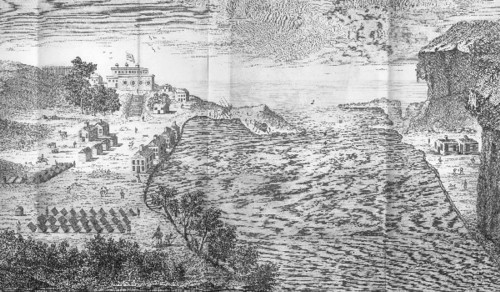|
Oswego Oswego was the name of the outpost or fort built on the south shore of Lake Ontario at the outlet of the Oswego River during the mid-1720s. Soon afterwards, fur traders built huts, then cabins, and then more substantial houses within sight of the fort. Located about 170 miles west of Albany, Oswego soon became an important trading location as well as a British military outpost. 
During three decades of peace (1714-44), the traders at Oswego became the active component of the Indian fur trade as Albany merchants sent their younger sons to the shores of Lake Ontario. Also, during that time, a number of Albany tradesmen and artifacers were paid for work done and services performed there. These also appear to be younger sons of established early families. The outbreak of war in 1754 and the capture and destruction of Oswego by the French in 1756 closed down the fur trade there until the 1760s. By that time, Oswego had been superceded as a point of contact. The British finally withdrew from Fort Ontario in 1796. It continuous settlement history dates from that time. Oswego was erected as a county in 1816. Because a number of Albany trading families maintained a prolonged business presence (just short of actual residence) at Oswego prior to the Revolution, this page will provide access to the Oswego connection to the people of colonial Albany! Sources: Regretably, Oswego has not been served with a research-based community study. Resources for its eighteenth-century history begin with Johnson G. Cooper's "Oswego in the French-English Struggle in North America, 1720-1760" (Ph. D. dissertation, Syracuse University, 1961). However, it is only superfically concerned with the actual settlement and development of community on the site! Documents supporting the early history of Oswego have been compiled and published as "Papers relating to the First Settlement and Capture of Fort Oswego, 1727-1756" in Documentary History of New York, volume 1, pp. 441-505. See also, the published papers of Sir William Johnson. Copy of an engraving entitled "The South View of Oswego on Lake Ontario" showing the forts, encampment, and trading houses at the mouth of the Oswego River about 1755. Reproduced in Documentary History of New York, volume 1, p. 495. The Albany presence at Oswego begins with members of the Bleecker family dating from the early eighteenth century. Albany native Pieter Schuyler, Jr. served as commissary at Oswego at times during the 1720s and 30s. After the Seven Years War, Albany traders were frequent visitors at Niagara, Detroit, and beyond. Swedish naturalist Peter Kalm spoke ill of the Albany traders. Kalm visited Oswego during the summer of 1750. Accounts for work done at Oswego (including transportation related activities) have been found scattered in the records of the provincial government rather than in the papers of the Albany city government. Home | Site Index | Navigation | Email | New York State Museum posted: 9/10/02; revised 7/6/07 |